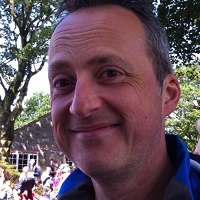 |
||
Haytham Kubba has been a Consultant in Children's ENT at Glasgow's Yorkhill Hospital since 2003, and is lead clinician for Scotland's National Service for Paediatric Airway Reconstruction Surgery. He graduated from the University of Newcastle upon Tyne in the North of England and trained in Glasgow with spells as a research registrar at the Medical Research Council’s Institute for Hearing Research and clinical fellow at Great Ormond Street Hospital in London. His clinical interests are neurodisability, head and neck malformations and airway surgery. He has published over a hundred research papers, with current projects on biomaterials for tracheal stents, pharyngeal pH measurement and human papilloma virus. Outside medicine he is a triathlete, bass guitarist and family man.
Paediatric Head & Neck Masses Children often present with masses in the neck and the aim of this talk is to discuss the wide differential diagnosis including branchial anomalies, vascular lesions and tumours, and a broad outline of management strategies for each.
By far the commonest cause of a neck mass in a child is reactive cervical lymhadenopathy. Ultimately, we would all like to minimise unneccessary investigations for the vast majority of children with palpable lymph nodes, whilst avoiding delays in diagnosis for the tiny minority with serious diagnoses such as malignancy. This talk will cover the results of an attempt to streamline and rationalise diagnosis in the child presenting with a cervical lymph node based on a systematic literature review, the development of a simple management algorithm and its subsequent validation in a large clinical series.
Saliva Control Multidisciplinary Clinic H Kubba, S Grosse
Dept of Paediatric Otolaryngology, Royal Hospital for Children, Glasgow, Scotland
Drooling of saliva is not uncommon in paediatric otolaryngology clinics. It can be a solitary finding in a pre-school child whose development is otherwise normal. Some children may have other oral motor issues such as problems with speech and chewing. Most, however, have drooling as one feature among many due to underlying neurological disease such as cerebral palsy. Drooling may coexist with chronic aspiration of saliva leading to coughing, choking and chest infections. Careful clinical assessment is necessary to rule out contributory medical problems such as medications, dental caries, malocclusion, gastric reflux and nasal obstruction. Management may include attention to these underlying problems, but also speech and language therapist intervention for oral awareness and oral motor skills, anticholinergic drugs, botulinum toxin injections and surgical procedures. Assessment and management are ideally done in a multidisciplinary environment where clinicians with complementary skills can tailor management to the needs of the child.
In Glasgow we have run a multidisciplinary saliva control clinic since 2006 and this talk will discuss our approach to diagnosis and management based on our published work including our analysis of the first 301 patients through the clinic1 and the first 97 children undergoing botulinum toxin injections2. Although children will often have a stepwise trial through different treatment options, the final successful treatment option in our clinic series was simple reassurance and advice for 12%, speech and language therapy in 23% anticholinergics in 33%, botulinum toxin in 11% and surgery in 26%. Significant rates of adverse events occur: 30% for anticholinergics and 11% for botulinum toxin.
References:
1. Montgomery J, McCusker S, Lang K, et al. Int J Ped Oto 2016; 85: 33-9
2. Montgomery J, McCusker S, Hendry J et al.Int J Ped Oto 2014; 78(11): 1970-3
Biomaterials for Tracheal Stents H Kubba, L Ferguson, I Adekanmbi*, E Tanner*
Dept of Paediatric Otolaryngology, Royal Hospital for Children, Glasgow and *Dept of Biomedical Engineering, University of Glasgow, Scotland
Tracheal lesions (malacia and stenosis) are some of the most difficult problems faced by the paediatric airway surgeon. Tracheobronchomalacia is fairly common and usually improves with time, but if symptoms are severe then tracheostomy with home ventilation may be required for a period of years until the condition improves. Tracheal stenosis is rare and may be acquired from intubation, or it may be congenital (complete rings or cartilage sleeve anomalies). Slide tracheoplasty and resection with end-to-end anastomosis are major procedures requiring cardiopulmonary bypass and they have significant complication rates due to poor healing, granulation and anastomotic stricture. There are many children for whom it would be very tempting to place an indwelling tracheal stent, given that this is a quick and easy bronchoscopic procedure that often results in immediate relief of symptoms. Metallic stents are widely available for use in cardiology but we only ever use them as a last resort in the airway. Their short term success is outweighed in almost all cases by their potential for long term complications. Once in, they are difficult and hazardous to remove, and erosion with migration outside the trachea are well known to occur.
In an ideal world, we would have a bioabsorbable stent that has all the advantages of easy, rapid bronchoscopic placement with immediate relief of symptoms, but which would slowly absorb over a year or so and thus avoid the long term concerns. This talk will cover issues with indwelling metallic stents based on clinical cases, plus drawbacks with current materials used for bioabsorbable stents such as polydioxanone (PDS). Early in vitro work on a novel bioabsorbable metallic alloy will be discussed as a potential ideal material for use in this context.
|
